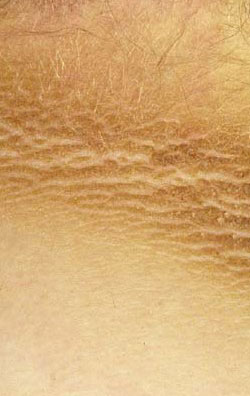
Acanthosis nigricans is a medical condition characterized by increased deposition of pigments (hyperpigmenation) along with thickening of the skin, especially in the body fold areas. Usually skin on the neck, especially on the back and the sides, armpits, groin, naval, forehead is affected. Other than the characteristic brownish black hyperpigmentation and velvety thickening the affected area may also smell bad.
Acanthosis nigricans is more common in people who are obese, suffering from diabetes or other hormone related problems like Addison’s disease, regularly takes certain drugs like oral contraceptive pills, have family history of acanthosis nigricans etc. In some cases presence of acanthosis nigricans may be one of the signs of cancer of internal organs like the stomach or liver.
This condition is also more common in blacks and Hispanics. Children may also suffer from this condition and these children are also at increased risk of suffering from type 2 diabetes in later life. As such there is no specific treatment available for acanthosis nigricans however, treatment of underlying cause helps to relieve the symptoms to some extent if not completely.
Symptoms
Acanthosis nigricans is a skin condition; the main presenting symptom is velvety thickening of skin on specific body parts like armpits, neck, forehead or other creases. Additionally the affected areas may also become itchy and smell bad.
This condition typically progresses over months to years. One of the most common complications associated with acnthosis nigricans is type 2 diabetes; hence patients of acanthosis nigricans should be screened periodically for type 2 diabetes. Sometimes acanthosis nigricans can be the only warning sign of cancer of some of the internal organs like lungs, liver etc.
Causes
The exact underlying cause of acanthosis nigricans is not known however there are number of associated factors which are usually associated with acanthosis nigricans. These are
1. Certain hormonal conditions, namely type 2 diabetes mellitus (insulin resistant), conditions associated with excess amount of circulating androgen Cushing’s disease, acromegaly, polycystic ovarian disease, Addison’s disease, hypothyroidism, certain rare hormonal diseases like pinealoma, Prader Wille syndrome, etc. In patients of acanthosis nigricans with hormonal problems there are certain characteristic features like insidious in onset, almost always associated with obesity and localized.
2. Obesity: in most of the cases of acanthosis nigricans, obesity is the most common cause
3. Certain drug intake: use of certain drugs like nicotinic acid, chronic use of glucocorticoids, oral contraceptive pills, hormone replacement therapy especially the growth hormone etc
4. Underlying malignancy: acanthosis nigricans may sometimes be associated with cancer of certain organs like stomach, lung, colon, liver, lymphoma, etc. In these cases acanthosis nigricans occur as a part of paraneoplastic syndrome. In these cases mucous membrane are affected mainly, also progresses quite rapidly and may also be accompanied by other skin conditions like skin tags, seborrheic keratosis, etc
Risk factors
Common risk factors include having excessive body weight (obesity), being Native American, Black or Hispanic, family history of acanthosis nigricans etc.
Treatment
Treatment of the underlying cause is the cornerstone of treatment of acanthosis nigricans. These include reduction of weight if obesity is the cause, drugs to control different underlying hormonal problems, if any, like hypothyroidism, Cushing’s disease, Addison’s disease, etc, surgical interventions to remove underlying cancerous tumors, if any, etc.
Sometimes prescription drugs like anti bacterial ointments, oral acne drugs etc are advised to lighten hyperpigmentation and laser therapy may also be used to restore normal skin texture.





